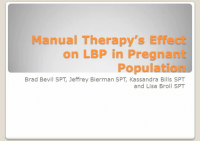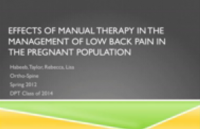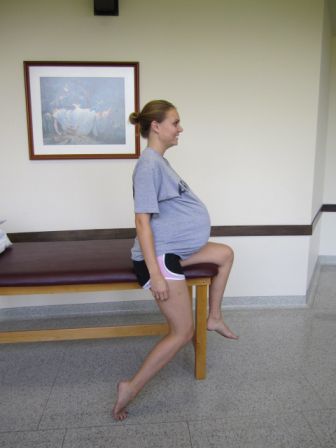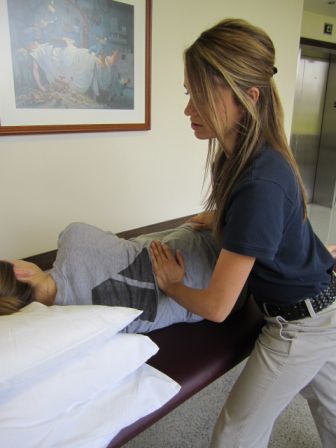Low Back Pain and Pregnancy: Difference between revisions
Aiko Deckers (talk | contribs) No edit summary |
Aiko Deckers (talk | contribs) No edit summary |
||
| Line 4: | Line 4: | ||
'''Top Contributors''' - {{Special:Contributors/{{FULLPAGENAME}}}} | '''Top Contributors''' - {{Special:Contributors/{{FULLPAGENAME}}}} | ||
</div> | </div> | ||
== Search Strategy == | == Search Strategy == | ||
Pubmed, Medline, Web of knowledge, books. | |||
[[Image:Definition1.png|right|150x200px]] | |||
<div><br></div> | |||
== Definition/Description<br> == | == Definition/Description<br> == | ||
<div><div> | |||
Pregnancy related low back pain is a common complaint that occurs in 60-70% of pregnancies [21] and can be defined as pain between the 12th rib and the gluteal folds/pubic symphysis during the course of pregnancy. This pain is not the result of a known pathology | |||
<div> | |||
such as disc herniation[25] and can begin at any point during pregnancy. Although most cases are mild, approximately one third of women experience severe pain.[11] Pregnancy related low back has been coined multiple times and can be referred to as one of the following patters: Low Back Pain (LBP), Peripartum Posterior Pelvic Pain (PPPP), Pregnancy-related low back pain (PLBP) or pregnancy-related pelvic gir | |||
dle pain (PPGP). The last two patterns can occur separately or combined.[21] <br>Unfortunately, there is limited research available regarding physical therapy intervention for pregnant women experiencing Low Back Pain, so a homogenous approach tends to be used. However, back pain is not homogenous; therefore special considerations and precautions should be taken when treating this population.<br><br> | |||
== Clinically Relevant Anatomy<ref name="Kapandji, deel 3">I.A. Kapandji. Bewegingsleer deel III de romp en wervelkolom. Bohn Stafleu van Loghum. Houten. 2009; 257 pages.</ref> == | == Clinically Relevant Anatomy<ref name="Kapandji, deel 3">I.A. Kapandji. Bewegingsleer deel III de romp en wervelkolom. Bohn Stafleu van Loghum. Houten. 2009; 257 pages.</ref> == | ||
| Line 197: | Line 201: | ||
<references /><br><br> | <references /><br><br> | ||
[[Category:Texas_State_University_EBP_Project]] [[Category:Pain]] [[Category:Lumbar]] [[Category:Womens_Health]] [[Category:Vrije_Universiteit_Brussel_Project]] [[Category:Musculoskeletal/Orthopaedics|Orthopaedics]]</div></div></div> | |||
[[Category:Texas_State_University_EBP_Project]] [[Category:Pain]] [[Category:Lumbar]] [[Category:Womens_Health]] [[Category:Vrije_Universiteit_Brussel_Project]] [[Category:Musculoskeletal/Orthopaedics|Orthopaedics]] | |||
Revision as of 12:03, 27 December 2013
Original Editors - Timothy Assi
Top Contributors - Lynse Brichau, Aiko Deckers, Admin, Brenda Walk, Corin Arundale, Timothy Assi, Christine Utskot, Joanne Garvey, Kim Jackson, Lauren Lopez, Nicole Hills, Chris Slininger, Rachael Lowe, Temitope Olowoyeye, Joshua Samuel, Uchechukwu Chukwuemeka, Evan Thomas, George Prudden, 127.0.0.1, Jeremy Brady and Laura Ritchie
Search Strategy[edit | edit source]
Pubmed, Medline, Web of knowledge, books.
Definition/Description
[edit | edit source]
Pregnancy related low back pain is a common complaint that occurs in 60-70% of pregnancies [21] and can be defined as pain between the 12th rib and the gluteal folds/pubic symphysis during the course of pregnancy. This pain is not the result of a known pathology
such as disc herniation[25] and can begin at any point during pregnancy. Although most cases are mild, approximately one third of women experience severe pain.[11] Pregnancy related low back has been coined multiple times and can be referred to as one of the following patters: Low Back Pain (LBP), Peripartum Posterior Pelvic Pain (PPPP), Pregnancy-related low back pain (PLBP) or pregnancy-related pelvic gir
dle pain (PPGP). The last two patterns can occur separately or combined.[21]
Unfortunately, there is limited research available regarding physical therapy intervention for pregnant women experiencing Low Back Pain, so a homogenous approach tends to be used. However, back pain is not homogenous; therefore special considerations and precautions should be taken when treating this population.
Clinically Relevant Anatomy[1][edit | edit source]
The lower back region – also called the lumbar region – is part of the spine and consists of fivevertebrae. This region has his own specific curvature - the lumbar lordosis, different from the upper thoracic and cervical region. These five lumbar vertebrae are also larger and wider because of their weight-bearing properties. The sacrum and coccyx are situated below the lumbar region. Two important ligaments connect the vertebral bodies of the spine: lig. longitudinale anterior and posterior. These long ligaments are attached to an intervertebral disc between two consecutive vertebrae. Lig. flavum, lig. interspinale, lig. intertransversarium, lig. anterius and posterius are other ligaments that provide stability due to the firm connection between the vertebrae. Furthermore, it is important to observe the functionality of some muscles related to low back pain: back muscles, pelvic muscles and abdominal muscles.
Epidemiology /Etiology[edit | edit source]
Previous studies (or reviews) investigated the prevalence of low-back pain during pregnancy in various populations. The results seemed very variable, ranging from 24% to more than 89,8%.[2][3][4][5][6][7] The international reported prevalence of PPGP - and/or low back pain - in the Netherlands was between 45% and 89%.[8]
The exact etiology of LBP during pregnancy is unknown, but there are known factors that are believed to be contributers. During pregnancy, hormonal changes occur, specifically the release of the hormone Relaxin, which is thought to contribute to ligament laxity, softening of cartilage, and the proliferation of synovium.[9] This causes ligament laxity specifically in the Sacro-Iliac Joint, and the Pubic Symphysis.
Another contributer is the increase in weight which is an average of 25-35 pounds gained during pregnancy. The weight gain increases the amount of force placed across joints, changes the center of gravity, and forces the patient into an anterior pelvic tilt. The anterior displacement of the center of gravity will cause women to shift their heads and upper body posteriorly over the pelvis, causing hyperlordosis of the lumbar spine, which places additional stress on the intervertebral discs, ligaments, and facet joints that can lead to joint inflammation. In addition, abdominal muscles are stretched and weakened, and the added weight can compress on the lumbosacral plexus. There are additional theories that vascular changes may occur during pregnancy, including pressure changes in the vena cava and aorta that lead to water retention, cause hypervolemia, decreased cardiac output, lower the blood pressure and raise heart rate, which can lead to ischemia and metabolic changes, inducing low back pain.
Risk factors for Low Back Pain during pregnancy include a history of LBP during pregnancy, multiple abortions, and smoking.[10]
Also another condition which may occur during pregnancy is called Diastasis Rectus Abominis, which is the separation of the Rectus Abdominis at the Linea Alba, leading to poor posture and LBP.[11]
While values are not known in the United States, in a single year in Sweden, sick leave associated with LBP in pregnancy accounted for $2.5 billion.
Characteristics/Clinical Presentation[edit | edit source]
The most common onset tends to be during the 5th and 6th month of gestation, and the pain is usually worse later on in the day. 67% of women suffer from pain at night. Factors that aggravate the pain include: standing, sitting, coughing or sneezing, walking, and straining during a bowel movement. During the physical exam, the paravertebral muscles are tender to palpation, the muscles of the back are weak during testing, and there is possible decreased ROM in flexion. The description of the pain is not localized at times, and may be intermittent. It is possible for the pain to radiate down as far as the calf.[10]
There is a lack of scientific clarity to the mechanism of this injury, yet there are several possible reasons. During pregnancy, changes occur in the facet joints, back muscles, ligaments and disc, which can affect the stability of the spine and lead to back pain. Increasing weight of the fetus causes a larger abdominal volume, allowing the abdominal muscles to be stretched and impaired.[12][13] Static equilibrium interruption of the back and abdomen changes the center of gravity, resulting in posture adjustments and extra mechanical stress on the back.[12][14][15] As pregnancy progresses, relaxine concentration rises causing laxity of the lig. longitudinalis and weakening this strong ligament. The concentration of relaxin in women with severe pelvic girdle pain in pregnancy is significantly higher than woman without back pain.[14][16] Risk factors that increase the complaints were similar in some studies[4][5][8][17]: previous backpain history before pregnancy and multiparity. Some authors[6][18] believe that age, weight and height of the mother, fetal weight, the number of pregnancies, etc. are not risk factors, but this stays unclear since there are many studies with contradictory results.[3] The prevalence of low-back pain during pregnancy also depends on the moment of pregnancy, which is measured the highest during the third trimester of the pregnancy.[7][8]
Differential Diagnosis[edit | edit source]
There are other musculoskeletal disorders to consider, including Sciatica, Meralgia Paresthetica, Thoracic/Rib pain, Hip pain, coccodynia, spontaneous abortions, osteomyelitis, osteoarthritis, osteitis condensans ilii, metastatic cancers, and Diastasis Recti.
Differential Diagnosis for Disc Disease[19][edit | edit source]
Morning pain and stiffness, weight bearing, age of the patient, increased abdominal pressure provokes pain, sleep not usually disturbed, eases as day progresses and then gets worse again, history of repeated micro trauma, movement eases pain but not for long (e.g. fidgets), going up hill provokes pain, sitting too long provokes pain especially in low chairs, getting out of a chair provokes pain
Facet Joint Involvement[edit | edit source]
Non weight bearing, related to movement specifically rotation, pain increased by lateral compression, history of minor injury, pain is not usually referred to an extremity, eases with rest, not affected by coughing or sneezing
Sacroiliac Involvement[edit | edit source]
There is a definite laterality to pain, pain does not midline, can refer pain to the leg, turning in bed provokes pain, getting out of the car provokes pain, pain is referred to the groin or genitals, pain is related to menstruation prior to pregnancy because of the effects of cyclic hormones on pre-pregnant SIJ ligaments.
Diagnostic Procedures[edit | edit source]
To formulate a diagnosis, the patient her history (anamnesis), movement possibilities / limitations and help-request must be known. This will help the physiotherapist understand the patient her health problem and needs. Knowledge of the anatomical and functional disorders, activity limitations and restriction of participation will help the physiotherapist to estimate his role within the physiotherapy. It is important to recognize specific complaints – known as red flags. And if present, contact a doctor.[8]
Different measure instruments can be used in the diagnosis to estimate the complaints more objectively: Visual Analogue Scale (VAS)[20], Roland Disability Questionnaire (RDQ), Impact on Participation and Autonomy (IPA), PHotograph series Of Daily Activities (PHODA), Pain Behavior Scale (PBS).
Examination[edit | edit source]
History[edit | edit source]
Subjective questions:
- Have you experienced any complications with prior or the current pregnancy(s)?
- Has the physician given any precautions for therapy or exercise?
- Do you experience dizziness when lying on your back?
- Any lightheadedness?
- Is there anything you do that aggravates or eases the pain?
Physical Exam[edit | edit source]
During an examination of a patient who is pregnant, positioning is a key consideration. Excessive time in supine is not recommended due to the weight of the uterus on the vena cava and vital structures.[19] Examination should include observation of posture and gait, neurologic screen to rule out underlying pathology, range of motion, muscle tests, palpation, muscle length tests, and assessment of joint mobility. Special tests can include FABER and Trendelenberg.
Due to the level of pain and disability of the patient, and potentially the size of the pregnant abdomen, certain tests and measures may need to be modified for this population.
Modified Tests:[21][edit | edit source]
Hip Flexor Length: To modify the test position, have the patient sit on the edge of a table or mat, and extend the test leg as much as possible, while maintaining slight knee flexion. The pelvis should be kept in a neutral alignment. The examiner in one case study assumed that if the patient had normal flexibility, she would able to extend her hip perpendicular to the floor.
Modified Hip Flexor Assessment
Thomas Test
SI Joint Examination: The reliable test for measuring symmetry of the ASIS’ is in standing, but if the patient is unable to stand, a modification is to have the patient lying in supine, and have them perform a pelvic bridge. The purpose of the bridge is to align the pelvis in neutral, and then the ASIS’ can be palpated for symmetry in supine.
Innominate Torsion: The modification for this test is done in long-sitting. First, the patient was positioned in supine, and the medial malleoli are palpated, looking for discrepancies in length. Then, the medial malleoli are examined again in long-sitting, to see if there is any shortening of either leg .
Diastasis Recti Test: Position patient in hooklying, and have the patient lift the head and shoulders, and reach for their feet. Palpate the patient’s linea alba, and measure width of separation with fingers. One to 1.5 finger width separation is normal. Either two to 2.5 fingers or observation of a bulge at midline is considered abnormal, and the PT should exhibit caution with any intervention.
Medical Management (current best evidence)[edit | edit source]
As a physical therapist, it is important to ask the patient if they are having regular check ups by their obstetrician, and if they have any contraindications regarding exercise. A variety of precautions should be taken to manage LBP during pregnancy. Some interventions include: encouraging sidelying while sleeping (can be assisted by using a wedge-shaped pillow), using compression socks to promote venous return to the heart and reduce edema, support belts, soft tissue massage, acetaminophen use if approved by MD (NSAIDs are contraindicated).
While further researcher is needed, the use of support belts has preliminarily been shown to be an effective tool for decreasing pain intensity, duration and effect on ADLs. One such belt is The Loving Comfort support belt which is covered by Medicaid.[19]
Precautions include: Avoiding heavy lifting, holding breath while performing exercises, no moist heat on lower back, ultrasound, and electrical-stimulation.
According to the American College of Obstetricians and Gynecologists, exercise should be avoided if the following signs or symptoms are experienced:
Vaginal bleeding, dizziness or feeling faint, increased shortness of breath, chest pain, headache, muscle weakness, calf pain or swelling, uterine contractions, decreased fetal movement, fluid leaking from the vagina.[10]
Physical Therapy Management[edit | edit source]
Managment includes specific interventions to address pain, weakness, and mobilty in the pelvic girdle and low back region. After reviewing the research, common interventions that were found to be effective included: two maual therapy techniques and three therapeutic exercises.
The way of treatment depends on the diagnosis and timing of pregnancy (before or after childbirth). Firstly, the patient should understand her own symptoms and be motivated to remain active. Back care advice [6] and exercise during second half of the pregnancy [22] significantly reduces LBP. Postural education can prevent unnecessary mechanical stress on the back [23], therefore neutral postures during ADL and physical activities are recommended. Stability, coordination and functional preservation should be trained with active back exercises - endurance training for back muscles stabilization.[18] Pelvic tilts, knee pull, straight leg raising, curl up, lateral straight leg raising and water aerobics are recommended because it relieves lumbar pain in pregnancy.[23]
Manual Interventions:
[edit | edit source]
Posterior/Anterior Mobilizations in Sidelying to address pain and mobility (Grades 1-4).
Muscle Energy Technique by resisting hip flexion while stabilizing the sacrum (to correct anterior innominate rotation)
Exercises:
[edit | edit source]
Strengthening gluteus medius with clams in sidelying position.
Image:Marching_with_ADIM_small.jpg
Abdominal Drawing in Maneuver sitting on physioball. Can progress exercise by combining ADIM with lower extremity marching.
Latissimus dorsi pull-downs with glute sets to increase the strength of the posterior oblique sling mucles, which compress the SIJ.
Aerobic exercise: Walking, swimming, recumbent bicycle (or nustep), at a low to moderate intensity. The stress on the back should be minimal.
Resources
[edit | edit source]
Here is another page concerning lower back pain in pregnancy.
Clinical Bottom Line[edit | edit source]
Many pregnant women experience low back pain. Key questions must be asked and special modifications must be made with physical exam and treatment. Therefore, as patient centered practitioners, it is our job to research and implement evidence based practice to increase outcomes with minimal number of treatments with this special population.
Presentations[edit | edit source]
 |
Effects of Manual Therapy in the Management of Low Back Pain in the Pregnant Population
This presentation, created by Brad Bevil, Jeffrey Bierman, Kassandra Bills, and Lisa Broll; Texas State DPT Class. |
 |
Effects of Manual Therapy in the Management of Low Back Pain in the Pregnant Population
This presentation, created by Habeeb Adewale, Lisa Elliot, Rebecca Hogan, Taylor Clark; Texas State Class of 2014, Evidence-based Practice projects for PT7539 Ortho Spine course. |
Recent Related Research (from Pubmed)
[edit | edit source]
Failed to load RSS feed from http://eutils.ncbi.nlm.nih.gov/entrez/eutils/erss.cgi?rss_guid=14MpKbWO9zvFebubT4UTZKZm_0Q0VJ_VKdfcgw_JcJ0AWU29XI|charset=UTF-8|short|max=10: Error parsing XML for RSS
References
[edit | edit source]
- ↑ I.A. Kapandji. Bewegingsleer deel III de romp en wervelkolom. Bohn Stafleu van Loghum. Houten. 2009; 257 pages.
- ↑ Cite error: Invalid
<ref>tag; no text was provided for refs namedEndresen - ↑ 3.0 3.1 Cite error: Invalid
<ref>tag; no text was provided for refs namedBastiaanssen - ↑ 4.0 4.1 Mogren IM, Pohjanen AI. Low back pain and pelvic pain during pregnancy: prevalence and risk factors. Spine . 2005 Apr 15;30(8);983-91.(C)
- ↑ 5.0 5.1 Ostgaard HC, Andersson GBJ, Karlsson K. Prevalence of back pain in pregnancy. Spine 1991; 16: 549–52.(C) Cite error: Invalid
<ref>tag; name "Ostgaard, Prevalence of back pain in pregnancy" defined multiple times with different content - ↑ 6.0 6.1 6.2 Orvieto R, Achiron A, Ben-Rafael Z, Gelernter I, Achiron R. Low back pain of pregnancy. Acta Obstet Gynaecol Scand. 1994; 73: 209–14.(C)
- ↑ 7.0 7.1 Ansari NN, Hasson S, Naghdi S, Keyhani S, Jalaie S. Low back pain during pregnancy in Iranian women: Prevalence and risk factors. Physiotherapy Theory and Practice, 26(1):40–48, 2010(C)
- ↑ 8.0 8.1 8.2 8.3 C.H.G. Bastiaenen, E.J.M. Hendriks,A.L. Pool-Goudzwaard,N.T.M. Bernards,M.L. van Engelenburg-van Lonkhuyzen, C.P. Albers-Heitner,J. van der Meij,M.H.M. Grupping-Morel,R.A. de Bie. KNGF-richtlijn, Zwangerschapsgerelateerde bekkenpijn, Nederlands Tijdschrift voor Fysiotherapie,Jaargang 119 · Nummer 1; 2009 (D)
- ↑ Cite error: Invalid
<ref>tag; no text was provided for refs namedHall - ↑ 10.0 10.1 10.2 Cite error: Invalid
<ref>tag; no text was provided for refs namedSneag - ↑ Jeffcoat H. Exercises for low back pain in pregnancy. Int J Childbirth Educ. 2008; 23: 9-12.
- ↑ 12.0 12.1 J. Dequeker. Chronische lage rugpijn en invaliditeit – rugpijn in gynaecologie. Acco Leuven. 1979; 141 pages
- ↑ Wendy L Gilleard, J Mark M Brow.Structure and function of the abdominal muscles in primigravid subjects during pregnancy and the immediate postbirth period. Physical Therapy, 1996; 750-62(C)
- ↑ 14.0 14.1 R Russell, F Reynolds. Back pain, pregnancy, and childbirth. British medical journal. 1997;1059-1064.
- ↑ W. W. K. To, M. W. N. Wong. Factors associated with back pain symptoms in pregnancy and the persistence of pain 2 years after pregnancy. Acta Obstetricia et Gynecologica Scandinavica. 2003; 1086-91.(C)
- ↑ MacLennan AH, Nicolson R, Green RC, Bath M. Serum relaxin and pelvic pain of pregnancy. Lancet 1986;243-5.(B)
- ↑ Ostgaard HC, Andersson GBJ. Previous back pain and risk of developing back pain in a future pregnancy. Spine 1991; 16: 433–6.(C)
- ↑ 18.0 18.1 R. Meeusen. Praktijkgids Rug-en nekletsels deel1. Kluwer. 2001;154-56pages
- ↑ 19.0 19.1 19.2 Sandler SE. The Management of Low Back Pain in Pregnancy. Manual Therapy. 1996; 1(4):178-185
- ↑ M. Ronald, J.R. Jenner. Back pain New approaches to rehabilitation and education. Manchester university press. 1989;258 pages
- ↑ Cullaty M. Suspected Sacroiliac Joint Dysfunction: Modifying Examination and Intervention During Pregnancy. Journal of Women's Health Physical Therapy. 2006; 30(2): 18-24
- ↑ A. Garshasbi, S. Faghih Zadeh.The effect of exercise on the intensity of low back pain in pregnant women. International Journal of Gynecology and Obstetrics.2005; 88, 271—275(B)
- ↑ 23.0 23.1 J Sabino, Jonathan N. Grauer. Pregnancy and low back pain. Curr Rev Musculoskelet Med. 2008; 1:137–141(D)









